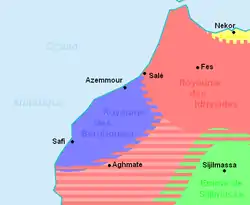Midrarid dynasty
Midrarid dynasty (also Banu Midrar or Midrarids) was a Berber dynasty that ruled the Tafilalt region in Morocco. It was established by the Berber Miknasi leader Abul-Qasim Samku.[1] The source for which details of his reign are told by Al-Bakri who lived in the following century; Ibn Idhari also mentions him, but he lived in the thirteenth and fourteenth centuries, and Ibn Khaldun (the fourteenth century) and some other minor historians, including at least two contemporary but partial sources.
Emirate of Sijilmasa Banu Midrar | |||||||||
|---|---|---|---|---|---|---|---|---|---|
| 757–976 | |||||||||
 Midrar kingdom (green). | |||||||||
| Capital | Sijilmasa | ||||||||
| Common languages | Berber | ||||||||
| Religion | Sufri Islam | ||||||||
| Government | Monarchy | ||||||||
| King | |||||||||
• 772 | Abu Kasem Semghu | ||||||||
| Historical era | Middle Ages | ||||||||
• Established | 757 | ||||||||
• Disestablished | 976 | ||||||||
| Currency | Midrar | ||||||||
| |||||||||
Part of a series on the |
|---|
| History of Morocco |
 |
|
|
Foundation
The dynasty would have been more or less linked to the founding of the city of Sijilmasa. According to the tradition collected by Al Bakri, the leader of Miknasa Abu Kasim Semgu son of Wasul Miknasi adopted the Kharigite doctrines propagated by Íkrima; and when he had 40 followers he began construction of Sijilmasa city in 757. The head of the community was a black man named Isa ibn Yazid the black for 15 years, but his government did not satisfy the Berbers, then Abu Khattab told his friends in Isa's council "all the blacks are thieves including him" (referring to Isa), then they took Isa and tied him to a tree in top of a mountain and left him alone until he died by mosquitoes in 772, the mountain was named mountain of Isa until this day. Later Midrar was ruled by the same Abu Kasim Semgu who ruled 13 years and died in 785.
List of kings
Wasulis
- Samgu ibn Wasul 772-785
- Ilyass ibn Abi Kasim 785-790
- Abu Muntasir Ilyass 790-823 / 824
Midrars
- Midrar ibn Yasah, known as Muntasir (victorious), 823 / 824-867
- Maymun ibn Rustumiyya, 867
- Maymun ibn Thakiyya, 867
- Muntasir ibn Yasah, 867 (second time)
- Maymun ibn Thakiyya, 867-877 (second time)
- Muhammad ibn Maymun, 877-883
- Yasah ibn Midrar, 883-909
- Wasul ibn Thakiyya, 909-913
- Ahmad ibn Thakiyya, 913-921
- Muhammad Mutazz ibn Saru, 921-933 / 934
- Muhammad ibn Muhammad, 933 / 934-942 / 943
- Samgu ibn Muhammad, 942/943
- Muhammad ibn Wasul 942 / 943-958
- Samgu ibn Muhammad (Muntasir Billah), 958-963
- Abd Allah ibn Muhammad, 963-976 / 977
References
- Abun-Nasr, Jamil M. (1987). A History of the Maghrib in the Islamic Period. Cambridge University Press. p. 49. ISBN 9781316583340.